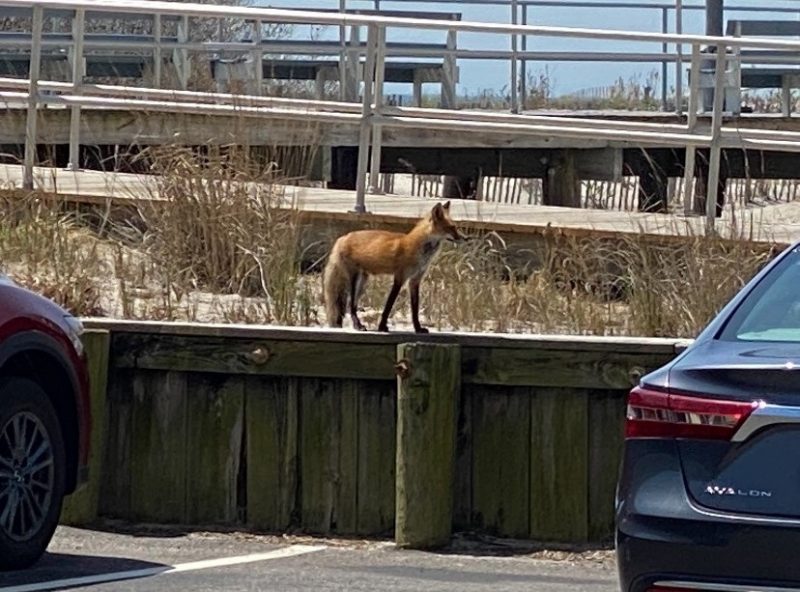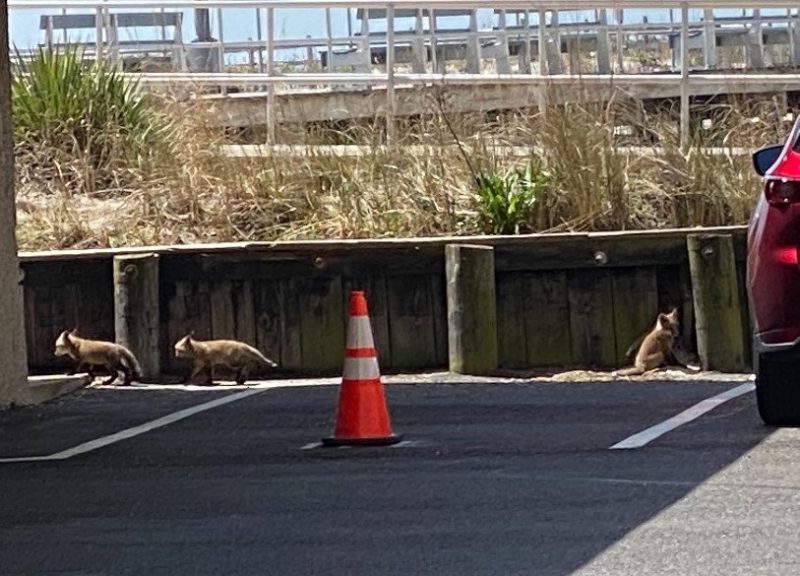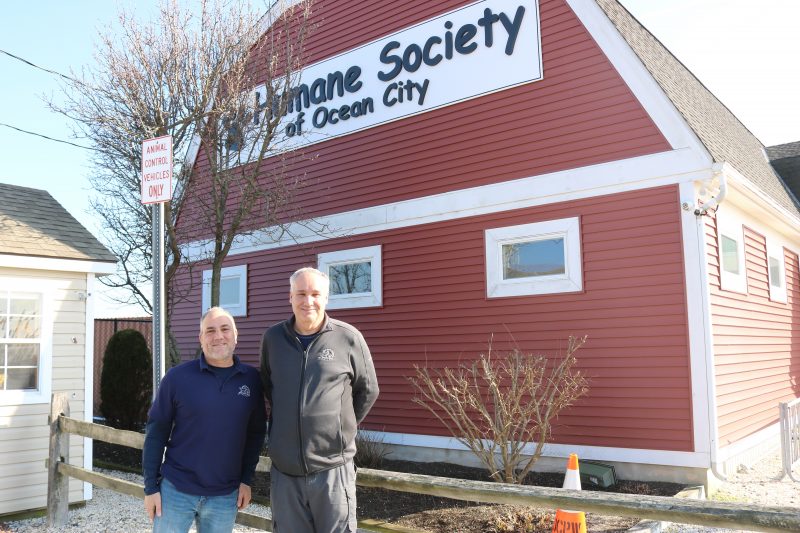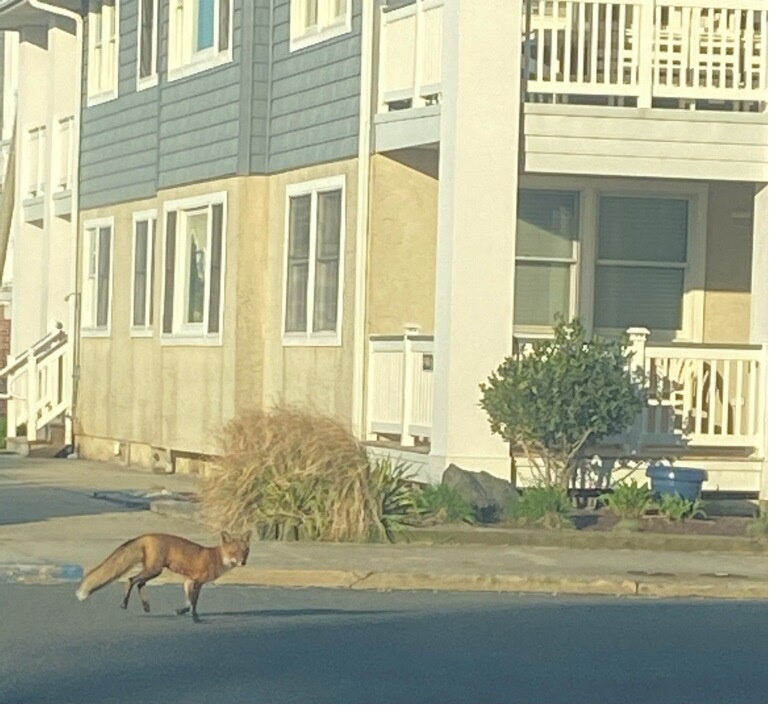 By TIM KELLY
By TIM KELLY
Toward the end of one of the busiest off-seasons in Ocean City history and just ahead of the annual arrival of seasonal visitors, the city’s fox population has been making its presence known.
“Denning” season is currently in full swing, wildlife experts said – the time when the reddish bushy-tailed creatures reproduce and make temporary homes around the island – to the amusement of many human residents.
“People don’t always associate Ocean City with wildlife,” said Phil Bellucci, Operations and Development Director, Animal Control Officer and Volunteer Coordinator of the Ocean City Humane Society.
“Whether they realize it or not, foxes have been around here for a long time and they are an important part of our eco-system,” he added.
For decades now, local foxes and their cousins living on neighboring barrier islands thrived in the South Jersey beach and bay environment. But they did so in a more low-key way, experts said. This year, because of remote working and schooling and other COVID-19 protocols, foxes are being noticed more.
Despite higher visibility, Belluci said COVID-19 most likely isn’t the main direct reason.
“Rabbits have increased in number, and rabbits are (the foxes’) natural delicacy,” he said.
In other words, where you see more rabbits, you might spot more foxes.
“Oh, she’s so pretty,” North End resident Ruth Ann Buch exclaimed earlier this week as she noticed an adult fox and three kits, or baby foxes, near a temporary home, just a few feet away from the sand dunes and the beach.
Buch, a retired nurse, laughed as one of the adult foxes stood sentry and the youngsters scurried about.
It is this process of “denning,” Bellucci said, in high visibility areas, as well as the animal’s adaption and lack of fear in co-existing with humans, which accounts for more people attempting to interact with them. Denning started right on schedule several weeks ago and is expected to last through the middle of May.
Buch, who was preparing for her daily bike ride, kept a respectful distance. But not all human encounters happen that way and can be detrimental to the foxes, as well as the local ecology, Bellucci explained.
“They are beautiful creatures and not a usual sight,” Bellucci said. “Some people want to get closer than they should, or want to interact with them. Go ahead and take your picture, just don’t move in any closer.”

Baby foxes, known as kits, frolic near their den.
Ocean City’s foxes are members of the North American Red Fox species, but a bit smaller than those found on the mainland. They thrive in Ocean City’s environment, which offers a wide variety of their natural prey.
Rabbits are their top choice and primary food, according to several wildlife websites. However, if none are around they also feast on a variety of small animals and birds found in the sand dunes and marshes here.
Bellucci said it was next to impossible to say how many foxes call Ocean City home.
“They keep moving around and many live in (areas inaccessible for monitoring),” he noted. “But they’re out there.”
We could find no documentation of foxes attacking humans or pets in Ocean City, but that doesn’t mean people should approach them.
Just as with gulls, turtles and other wildlife in Ocean City, humans sometimes feed the foxes inappropriately, or even try to touch them. On a recent sunny day, a Boardwalk stroller was seen dumping crackers near a den, which the animals immediately began chomping on.
The foxes “weren’t hungry” for crackers, Bellucci said. But, he said, the animals are smart and opportunistic. Given the chance for an easy handout, they’ll take it.
The problem, he said, is crackers aren’t a natural food source. Getting such an easy meal could discourage the foxes from hunting for their appropriate diet.
For example, near another Ocean City fox den, one of the adults scampered back to the kits with a large piece of rabbit. Another was seen with what appeared to be a crab. It was unclear if the latter was acquired naturally or from an open trash can.
A benefit local foxes enjoy is the home-building boom in Ocean City. Construction sites provide spaces well-suited for dens, such as crawl spaces and stairways. Of course, there are also thousands of natural spots the foxes called home before humans even settled here.
“(The Human Society’s) Animal Control should get a call if removal is necessary or if an animal is injured,” Bellucci said. “But in almost all of the situations, the best thing to do is to leave the foxes and the dens alone. They won’t be there for long.”
He said the kits remain under the protection of the adult foxes until they are ready to leave the den after about a month. Thus, in most cases, homes, sheds, and other buildings “hosting” a den won’t be doing so for long.
Sometimes, they even change their den location before the kits are ready to leave, Bellucci said.

Humane Society of Ocean City Operations Manager Phil Bellucci, left, shown with HSOC Executive Director Bill Hollingsworth, says the fox population appears healthy and active this year.
The last time Ocean City’s fox population gained media attention was 2018, when a den near a local donut shop would hang out on the Boardwalk and wait for humans to toss them pieces of the fresh-baked sugary treats.
In another publicized incident, a fox ran onto the field at the soccer complex near the Humane Society, apparently unafraid of the players, spectators or game action. The game was temporarily halted until the critter finally left.
Also that year, a number of foxes were stricken with mange, a skin disease that is painful and often fatal to the animals. In that case, Animal Control would attempt to capture the foxes and euthanize those that are suffering.
The Humane Society, at 1 Shelter Road, is open daily from 11 a.m. to 3 p.m. In addition to Animal Control, it offers a full service veterinary clinic, shelter, adoption services and more. Visit its website at
hsocnj.org for additional information on services and events.
This year, Ocean City’s foxes are healthy, strong, active and living in concert with other wildlife and humans.
To keep it that way, Bellucci said residents and visitors should dispose of their garbage and recyclables properly, make sure trash can lids are clamped down securely, keep their dog on a leash, seal off areas that could be used as a den, and most importantly, resist the urge to get close to the cute and furry critters.
He said that when the exact locations of dens become known, “some people talk about it or post things on social media. And now you have others coming around looking for the animals.”
That’s not good for the foxes or for (Ocean City),” Bellucci added.
If people want to see the foxes, they are not hard to find, Bellucci said.
“Foxes and other wildlife are part of our environment,” he continued. “Folks should admire our wildlife the same way they should appreciate the ocean. Observe and enjoy their beauty. But do so from a distance and look at the animals with a sense of respect.”

A fox runs down the street in Ocean City.
 By TIM KELLY
Toward the end of one of the busiest off-seasons in Ocean City history and just ahead of the annual arrival of seasonal visitors, the city’s fox population has been making its presence known.
“Denning” season is currently in full swing, wildlife experts said – the time when the reddish bushy-tailed creatures reproduce and make temporary homes around the island – to the amusement of many human residents.
“People don’t always associate Ocean City with wildlife,” said Phil Bellucci, Operations and Development Director, Animal Control Officer and Volunteer Coordinator of the Ocean City Humane Society.
“Whether they realize it or not, foxes have been around here for a long time and they are an important part of our eco-system,” he added.
For decades now, local foxes and their cousins living on neighboring barrier islands thrived in the South Jersey beach and bay environment. But they did so in a more low-key way, experts said. This year, because of remote working and schooling and other COVID-19 protocols, foxes are being noticed more.
Despite higher visibility, Belluci said COVID-19 most likely isn’t the main direct reason.
“Rabbits have increased in number, and rabbits are (the foxes’) natural delicacy,” he said.
In other words, where you see more rabbits, you might spot more foxes.
“Oh, she’s so pretty,” North End resident Ruth Ann Buch exclaimed earlier this week as she noticed an adult fox and three kits, or baby foxes, near a temporary home, just a few feet away from the sand dunes and the beach.
Buch, a retired nurse, laughed as one of the adult foxes stood sentry and the youngsters scurried about.
It is this process of “denning,” Bellucci said, in high visibility areas, as well as the animal’s adaption and lack of fear in co-existing with humans, which accounts for more people attempting to interact with them. Denning started right on schedule several weeks ago and is expected to last through the middle of May.
Buch, who was preparing for her daily bike ride, kept a respectful distance. But not all human encounters happen that way and can be detrimental to the foxes, as well as the local ecology, Bellucci explained.
“They are beautiful creatures and not a usual sight,” Bellucci said. “Some people want to get closer than they should, or want to interact with them. Go ahead and take your picture, just don’t move in any closer.”
By TIM KELLY
Toward the end of one of the busiest off-seasons in Ocean City history and just ahead of the annual arrival of seasonal visitors, the city’s fox population has been making its presence known.
“Denning” season is currently in full swing, wildlife experts said – the time when the reddish bushy-tailed creatures reproduce and make temporary homes around the island – to the amusement of many human residents.
“People don’t always associate Ocean City with wildlife,” said Phil Bellucci, Operations and Development Director, Animal Control Officer and Volunteer Coordinator of the Ocean City Humane Society.
“Whether they realize it or not, foxes have been around here for a long time and they are an important part of our eco-system,” he added.
For decades now, local foxes and their cousins living on neighboring barrier islands thrived in the South Jersey beach and bay environment. But they did so in a more low-key way, experts said. This year, because of remote working and schooling and other COVID-19 protocols, foxes are being noticed more.
Despite higher visibility, Belluci said COVID-19 most likely isn’t the main direct reason.
“Rabbits have increased in number, and rabbits are (the foxes’) natural delicacy,” he said.
In other words, where you see more rabbits, you might spot more foxes.
“Oh, she’s so pretty,” North End resident Ruth Ann Buch exclaimed earlier this week as she noticed an adult fox and three kits, or baby foxes, near a temporary home, just a few feet away from the sand dunes and the beach.
Buch, a retired nurse, laughed as one of the adult foxes stood sentry and the youngsters scurried about.
It is this process of “denning,” Bellucci said, in high visibility areas, as well as the animal’s adaption and lack of fear in co-existing with humans, which accounts for more people attempting to interact with them. Denning started right on schedule several weeks ago and is expected to last through the middle of May.
Buch, who was preparing for her daily bike ride, kept a respectful distance. But not all human encounters happen that way and can be detrimental to the foxes, as well as the local ecology, Bellucci explained.
“They are beautiful creatures and not a usual sight,” Bellucci said. “Some people want to get closer than they should, or want to interact with them. Go ahead and take your picture, just don’t move in any closer.”
 Baby foxes, known as kits, frolic near their den.
Ocean City’s foxes are members of the North American Red Fox species, but a bit smaller than those found on the mainland. They thrive in Ocean City’s environment, which offers a wide variety of their natural prey.
Rabbits are their top choice and primary food, according to several wildlife websites. However, if none are around they also feast on a variety of small animals and birds found in the sand dunes and marshes here.
Bellucci said it was next to impossible to say how many foxes call Ocean City home.
“They keep moving around and many live in (areas inaccessible for monitoring),” he noted. “But they’re out there.”
We could find no documentation of foxes attacking humans or pets in Ocean City, but that doesn’t mean people should approach them.
Just as with gulls, turtles and other wildlife in Ocean City, humans sometimes feed the foxes inappropriately, or even try to touch them. On a recent sunny day, a Boardwalk stroller was seen dumping crackers near a den, which the animals immediately began chomping on.
The foxes “weren’t hungry” for crackers, Bellucci said. But, he said, the animals are smart and opportunistic. Given the chance for an easy handout, they’ll take it.
The problem, he said, is crackers aren’t a natural food source. Getting such an easy meal could discourage the foxes from hunting for their appropriate diet.
For example, near another Ocean City fox den, one of the adults scampered back to the kits with a large piece of rabbit. Another was seen with what appeared to be a crab. It was unclear if the latter was acquired naturally or from an open trash can.
A benefit local foxes enjoy is the home-building boom in Ocean City. Construction sites provide spaces well-suited for dens, such as crawl spaces and stairways. Of course, there are also thousands of natural spots the foxes called home before humans even settled here.
“(The Human Society’s) Animal Control should get a call if removal is necessary or if an animal is injured,” Bellucci said. “But in almost all of the situations, the best thing to do is to leave the foxes and the dens alone. They won’t be there for long.”
He said the kits remain under the protection of the adult foxes until they are ready to leave the den after about a month. Thus, in most cases, homes, sheds, and other buildings “hosting” a den won’t be doing so for long.
Sometimes, they even change their den location before the kits are ready to leave, Bellucci said.
Baby foxes, known as kits, frolic near their den.
Ocean City’s foxes are members of the North American Red Fox species, but a bit smaller than those found on the mainland. They thrive in Ocean City’s environment, which offers a wide variety of their natural prey.
Rabbits are their top choice and primary food, according to several wildlife websites. However, if none are around they also feast on a variety of small animals and birds found in the sand dunes and marshes here.
Bellucci said it was next to impossible to say how many foxes call Ocean City home.
“They keep moving around and many live in (areas inaccessible for monitoring),” he noted. “But they’re out there.”
We could find no documentation of foxes attacking humans or pets in Ocean City, but that doesn’t mean people should approach them.
Just as with gulls, turtles and other wildlife in Ocean City, humans sometimes feed the foxes inappropriately, or even try to touch them. On a recent sunny day, a Boardwalk stroller was seen dumping crackers near a den, which the animals immediately began chomping on.
The foxes “weren’t hungry” for crackers, Bellucci said. But, he said, the animals are smart and opportunistic. Given the chance for an easy handout, they’ll take it.
The problem, he said, is crackers aren’t a natural food source. Getting such an easy meal could discourage the foxes from hunting for their appropriate diet.
For example, near another Ocean City fox den, one of the adults scampered back to the kits with a large piece of rabbit. Another was seen with what appeared to be a crab. It was unclear if the latter was acquired naturally or from an open trash can.
A benefit local foxes enjoy is the home-building boom in Ocean City. Construction sites provide spaces well-suited for dens, such as crawl spaces and stairways. Of course, there are also thousands of natural spots the foxes called home before humans even settled here.
“(The Human Society’s) Animal Control should get a call if removal is necessary or if an animal is injured,” Bellucci said. “But in almost all of the situations, the best thing to do is to leave the foxes and the dens alone. They won’t be there for long.”
He said the kits remain under the protection of the adult foxes until they are ready to leave the den after about a month. Thus, in most cases, homes, sheds, and other buildings “hosting” a den won’t be doing so for long.
Sometimes, they even change their den location before the kits are ready to leave, Bellucci said.
 Humane Society of Ocean City Operations Manager Phil Bellucci, left, shown with HSOC Executive Director Bill Hollingsworth, says the fox population appears healthy and active this year.
The last time Ocean City’s fox population gained media attention was 2018, when a den near a local donut shop would hang out on the Boardwalk and wait for humans to toss them pieces of the fresh-baked sugary treats.
In another publicized incident, a fox ran onto the field at the soccer complex near the Humane Society, apparently unafraid of the players, spectators or game action. The game was temporarily halted until the critter finally left.
Also that year, a number of foxes were stricken with mange, a skin disease that is painful and often fatal to the animals. In that case, Animal Control would attempt to capture the foxes and euthanize those that are suffering.
The Humane Society, at 1 Shelter Road, is open daily from 11 a.m. to 3 p.m. In addition to Animal Control, it offers a full service veterinary clinic, shelter, adoption services and more. Visit its website at hsocnj.org for additional information on services and events.
This year, Ocean City’s foxes are healthy, strong, active and living in concert with other wildlife and humans.
To keep it that way, Bellucci said residents and visitors should dispose of their garbage and recyclables properly, make sure trash can lids are clamped down securely, keep their dog on a leash, seal off areas that could be used as a den, and most importantly, resist the urge to get close to the cute and furry critters.
He said that when the exact locations of dens become known, “some people talk about it or post things on social media. And now you have others coming around looking for the animals.”
That’s not good for the foxes or for (Ocean City),” Bellucci added.
If people want to see the foxes, they are not hard to find, Bellucci said.
“Foxes and other wildlife are part of our environment,” he continued. “Folks should admire our wildlife the same way they should appreciate the ocean. Observe and enjoy their beauty. But do so from a distance and look at the animals with a sense of respect.”
Humane Society of Ocean City Operations Manager Phil Bellucci, left, shown with HSOC Executive Director Bill Hollingsworth, says the fox population appears healthy and active this year.
The last time Ocean City’s fox population gained media attention was 2018, when a den near a local donut shop would hang out on the Boardwalk and wait for humans to toss them pieces of the fresh-baked sugary treats.
In another publicized incident, a fox ran onto the field at the soccer complex near the Humane Society, apparently unafraid of the players, spectators or game action. The game was temporarily halted until the critter finally left.
Also that year, a number of foxes were stricken with mange, a skin disease that is painful and often fatal to the animals. In that case, Animal Control would attempt to capture the foxes and euthanize those that are suffering.
The Humane Society, at 1 Shelter Road, is open daily from 11 a.m. to 3 p.m. In addition to Animal Control, it offers a full service veterinary clinic, shelter, adoption services and more. Visit its website at hsocnj.org for additional information on services and events.
This year, Ocean City’s foxes are healthy, strong, active and living in concert with other wildlife and humans.
To keep it that way, Bellucci said residents and visitors should dispose of their garbage and recyclables properly, make sure trash can lids are clamped down securely, keep their dog on a leash, seal off areas that could be used as a den, and most importantly, resist the urge to get close to the cute and furry critters.
He said that when the exact locations of dens become known, “some people talk about it or post things on social media. And now you have others coming around looking for the animals.”
That’s not good for the foxes or for (Ocean City),” Bellucci added.
If people want to see the foxes, they are not hard to find, Bellucci said.
“Foxes and other wildlife are part of our environment,” he continued. “Folks should admire our wildlife the same way they should appreciate the ocean. Observe and enjoy their beauty. But do so from a distance and look at the animals with a sense of respect.”
 A fox runs down the street in Ocean City.
A fox runs down the street in Ocean City.